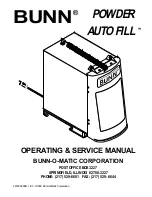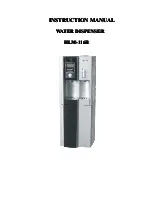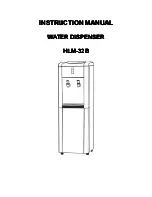
19
Restricting airflow may result in poor product
performance, product failure, and uneven internal
temperatures and may freeze contents.
•
Do not block the front grille - no additional clearance
around sides, top or rear of unit is needed for ventilation
•
Do not install behind a closed door
•
When loading, leave space between internal fans, vents,
and side walls to allow air to circulate freely
NOTICE
AIRFLOW
External
Internal
Airflow and Product Loading
USER GUIDE
u-line.com
Cleaning
Cleaning
CLEANING VS. SANITIZING
This guide will address both the cleaning and the sanitizing
of the unit.
Clean the unit to remove dried food and spills, to prevent
build-up of grime, and to maintain the natural luster
stainless steel surfaces.
Sanitize the unit when exposed to raw meat juice or
human germs such as from a sneeze or being touched by
someone who is ill. Sanitizing the unit can also be part of
regular cleaning routine.
Stainless Surfaces
Stainless door panels, handles and frames can discolor
when exposed to chlorine gas, pool chemicals, saltwater or
cleaners with bleach.
Keep your stainless unit looking new by cleaning with a
good quality all-in-one stainless steel cleaner and polish
monthly. For best results use Claire
®
Stainless Steel
Polish and Cleaner. Comparable products are acceptable.
Frequent cleaning will remove surface contamination that
could lead to rust. Some installations may require cleaning
weekly.
Do not clean with steel wool pads.
Do not use stainless steel cleaners or polishes on
any glass surfaces.
Clean any glass surfaces with a non-chlorine glass cleaner.
Do not use cleaners not specifically intended for
stainless steel on stainless steel surfaces (this
includes glass, tile, and counter cleaners).
If any surface discoloring or rusting appears, clean it
quickly with Bon-Ami
®
or Barkeepers Friend Cleanser
®
and
a nonabrasive cloth. Always clean with the grain. Always
finish with Claire
®
Stainless Steel Polish and Cleaner or
comparable product to prevent further problems.
Using abrasive pads such as ScotchBrite™ will
cause the graining in the stainless steel to
become blurred.
Rust not cleaned up promptly can penetrate the
surface of the stainless steel and complete
removal of the rust may not be possible.
CLEAN INTERIOR COMPONENTS
Use warm or hot water with dish soap to clean all removed
components and interior surfaces. You may use a vinegar and
water solution in place of soap. Proceed to sanitizing.
Note: Cleaning soaps and vinegar solutions are not
sanitizers.
SANITIZE INTERIOR COMPONENTS AND SURFACES
Choose a Commercial Sanitizer Safe for Stainless
Steel
• Read the directions for proper use to ensure that the
surface will actually be sanitized
•
Many products require rinsing with water after use,
especially when food will be touching the surface
•
Some products require a wait time before rinsing
•
Verify the sanitizer you are using is safe for stainless
steel.
Mix Your Own Sanitizer
Isopropyl Alcohol (rubbing alcohol)
1. Fill a clean, empty spray bottle with isopropyl alcohol
2. Spray surface
3. Wait 20 minutes
4. Dampen a non-abrasive cloth with isopropyl alcohol and
wipe down surface
5. Dry surface with a clean dry non-abrasive cloth
Unscented Bleach and Water
1. Create a solution of 1 tablespoon of unscented bleach
with one gallon of water.
2. Submerse small parts for no more than 3 minutes - rinse
immediately and allow to air dry or dry with a disposable
paper towel.
3. Fill a clean, empty spray bottle with bleach solution.
4. Spray surface.
5. After 2-3 minutes, use clean potable water to thoroughly
rinse off surface. Allow to air dry or dry with a disposable
paper towel.
6. Sanitize the door and all holes where the hinges attach to
the unit and the brackets attach to the door as well as all
the screws.
CLEAN EXTERIOR SURFACES
Use Bon-Ami
®
or Barkeepers Friend Cleanser
®
and a
nonabrasive cloth. Always clean with the grain. Always finish
with Claire
®
Stainless Steel Polish and Cleaner or comparable
product to prevent further problems.
USER GUIDE
u-line.com
Cleaning
Cleaning
CLEANING VS. SANITIZING
This guide will address both the cleaning and the sanitizing
of the unit.
Clean the unit to remove dried food and spills, to prevent
build-up of grime, and to maintain the natural luster
stainless steel surfaces.
Sanitize the unit when exposed to raw meat juice or
human germs such as from a sneeze or being touched by
someone who is ill. Sanitizing the unit can also be part of
regular cleaning routine.
Stainless Surfaces
Stainless door panels, handles and frames can discolor
when exposed to chlorine gas, pool chemicals, saltwater or
cleaners with bleach.
Keep your stainless unit looking new by cleaning with a
good quality all-in-one stainless steel cleaner and polish
monthly. For best results use Claire
®
Stainless Steel
Polish and Cleaner. Comparable products are acceptable.
Frequent cleaning will remove surface contamination that
could lead to rust. Some installations may require cleaning
weekly.
Do not clean with steel wool pads.
Do not use stainless steel cleaners or polishes on
any glass surfaces.
Clean any glass surfaces with a non-chlorine glass cleaner.
Do not use cleaners not specifically intended for
stainless steel on stainless steel surfaces (this
includes glass, tile, and counter cleaners).
If any surface discoloring or rusting appears, clean it
quickly with Bon-Ami
®
or Barkeepers Friend Cleanser
®
and
a nonabrasive cloth. Always clean with the grain. Always
finish with Claire
®
Stainless Steel Polish and Cleaner or
comparable product to prevent further problems.
Using abrasive pads such as ScotchBrite™ will
cause the graining in the stainless steel to
become blurred.
Rust not cleaned up promptly can penetrate the
surface of the stainless steel and complete
removal of the rust may not be possible.
CLEAN INTERIOR COMPONENTS
Use warm or hot water with dish soap to clean all removed
components and interior surfaces. You may use a vinegar and
water solution in place of soap. Proceed to sanitizing.
Note: Cleaning soaps and vinegar solutions are not
sanitizers.
SANITIZE INTERIOR COMPONENTS AND SURFACES
Choose a Commercial Sanitizer Safe for Stainless
Steel
•
Read the directions for proper use to ensure that the
surface will actually be sanitized
•
Many products require rinsing with water after use,
especially when food will be touching the surface
•
Some products require a wait time before rinsing
•
Verify the sanitizer you are using is safe for stainless
steel.
Mix Your Own Sanitizer
Isopropyl Alcohol (rubbing alcohol)
1. Fill a clean, empty spray bottle with isopropyl alcohol
2. Spray surface
3. Wait 20 minutes
4. Dampen a non-abrasive cloth with isopropyl alcohol and
wipe down surface
5. Dry surface with a clean dry non-abrasive cloth
Unscented Bleach and Water
1. Create a solution of 1 tablespoon of unscented bleach
with one gallon of water.
2. Submerse small parts for no more than 3 minutes - rinse
immediately and allow to air dry or dry with a disposable
paper towel.
3. Fill a clean, empty spray bottle with bleach solution.
4. Spray surface.
5. After 2-3 minutes, use clean potable water to thoroughly
rinse off surface. Allow to air dry or dry with a disposable
paper towel.
6. Sanitize the door and all holes where the hinges attach to
the unit and the brackets attach to the door as well as all
the screws.
CLEAN EXTERIOR SURFACES
Use Bon-Ami
®
or Barkeepers Friend Cleanser
®
and a
nonabrasive cloth. Always clean with the grain. Always finish
with Claire
®
Stainless Steel Polish and Cleaner or comparable
product to prevent further problems.
USER GUIDE
u-line.com
Cleaning
Cleaning
CLEANING VS. SANITIZING
This guide will address both the cleaning and the sanitizing
of the unit.
Clean the unit to remove dried food and spills, to prevent
build-up of grime, and to maintain the natural luster
stainless steel surfaces.
Sanitize the unit when exposed to raw meat juice or
human germs such as from a sneeze or being touched by
someone who is ill. Sanitizing the unit can also be part of
regular cleaning routine.
Stainless Surfaces
Stainless door panels, handles and frames can discolor
when exposed to chlorine gas, pool chemicals, saltwater or
cleaners with bleach.
Keep your stainless unit looking new by cleaning with a
good quality all-in-one stainless steel cleaner and polish
monthly. For best results use Claire
®
Stainless Steel
Polish and Cleaner. Comparable products are acceptable.
Frequent cleaning will remove surface contamination that
could lead to rust. Some installations may require cleaning
weekly.
Do not clean with steel wool pads.
Do not use stainless steel cleaners or polishes on
any glass surfaces.
Clean any glass surfaces with a non-chlorine glass cleaner.
Do not use cleaners not specifically intended for
stainless steel on stainless steel surfaces (this
includes glass, tile, and counter cleaners).
If any surface discoloring or rusting appears, clean it
quickly with Bon-Ami
®
or Barkeepers Friend Cleanser
®
and
a nonabrasive cloth. Always clean with the grain. Always
finish with Claire
®
Stainless Steel Polish and Cleaner or
comparable product to prevent further problems.
Using abrasive pads such as ScotchBrite™ will
cause the graining in the stainless steel to
become blurred.
Rust not cleaned up promptly can penetrate the
surface of the stainless steel and complete
removal of the rust may not be possible.
CLEAN INTERIOR COMPONENTS
Use warm or hot water with dish soap to clean all removed
components and interior surfaces. You may use a vinegar and
water solution in place of soap. Proceed to sanitizing.
Note: Cleaning soaps and vinegar solutions are not
sanitizers.
SANITIZE INTERIOR COMPONENTS AND SURFACES
Choose a Commercial Sanitizer Safe for Stainless
Steel
•
Read the directions for proper use to ensure that the
surface will actually be sanitized
•
Many products require rinsing with water after use,
especially when food will be touching the surface
•
Some products require a wait time before rinsing
•
Verify the sanitizer you are using is safe for stainless
steel.
Mix Your Own Sanitizer
Isopropyl Alcohol (rubbing alcohol)
1. Fill a clean, empty spray bottle with isopropyl alcohol
2. Spray surface
3. Wait 20 minutes
4. Dampen a non-abrasive cloth with isopropyl alcohol and
wipe down surface
5. Dry surface with a clean dry non-abrasive cloth
Unscented Bleach and Water
1. Create a solution of 1 tablespoon of unscented bleach
with one gallon of water.
2. Submerse small parts for no more than 3 minutes - rinse
immediately and allow to air dry or dry with a disposable
paper towel.
3. Fill a clean, empty spray bottle with bleach solution.
4. Spray surface.
5. After 2-3 minutes, use clean potable water to thoroughly
rinse off surface. Allow to air dry or dry with a disposable
paper towel.
6. Sanitize the door and all holes where the hinges attach to
the unit and the brackets attach to the door as well as all
the screws.
CLEAN EXTERIOR SURFACES
Use Bon-Ami
®
or Barkeepers Friend Cleanser
®
and a
nonabrasive cloth. Always clean with the grain. Always finish
with Claire
®
Stainless Steel Polish and Cleaner or comparable
product to prevent further problems.




































